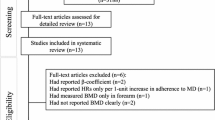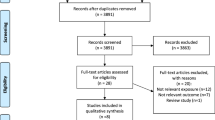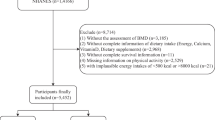Abstract
Summary
The association between adherence to Mediterranean diet (MD) and hip fracture incidence is not yet established. In a diverse population of elderly, increased adherence to MD was associated with lower hip fracture incidence. Except preventing major chronic diseases, adhering to MD might have additional benefits in lowering hip fracture risk.
Introduction
Hip fractures constitute a major public health problem among older adults. Latest evidence links adherence to Mediterranean diet (MD) with reduced hip fracture risk, but still more research is needed to elucidate this relationship. The potential association of adherence to MD with hip fracture incidence was explored among older adults.
Methods
A total of 140,775 adults (116,176 women, 24,599 men) 60 years and older, from five cohorts from Europe and the USA, were followed-up for 1,896,219 person-years experiencing 5454 hip fractures. Diet was assessed at baseline by validated, cohort-specific, food-frequency questionnaires, and hip fractures were ascertained through patient registers or telephone interviews/questionnaires. Adherence to MD was evaluated by a scoring system on a 10-point scale modified to be applied also to non-Mediterranean populations. In order to evaluate the association between MD and hip fracture incidence, cohort-specific hazard ratios (HR), adjusted for potential confounders, were estimated using Cox proportional-hazards regression and pooled estimates were subsequently derived implementing random-effects meta-analysis.
Results
A two-point increase in the score was associated with a significant 4% decrease in hip fracture risk (pooled adjusted HR 0.96; 95% confidence interval (95% CI) 0.92–0.99, pheterogeneity = 0.446). In categorical analyses, hip fracture risk was lower among men and women with moderate (HR 0.93; 95% CI 0.87–0.99) and high (HR 0.94; 95% CI 0.87–1.01) adherence to the score compared with those with low adherence.
Conclusions
In this large sample of older adults from Europe and the USA, increased adherence to MD was associated with lower hip fracture incidence.


Similar content being viewed by others
References
Kanis JA, Odén A, EV MC, Johansson H, Wahl DA, Cooper C, IOF Working Group on Epidemiology and Quality of Life (2012) A systematic review of hip fracture incidence and probability of fracture worldwide. Osteoporos Int 23(9):2239–2256
Odén A, McCloskey EV, Kanis JA, Harvey NC, Johansson H (2015) Burden of high fracture probability worldwide: secular increases 2010-2040. Osteoporos Int 26(9):2243–2248
Ward KA, Prentice A, Kuh DL, Adams JE, Ambrosini GL (2016) Life course dietary patterns and bone health in later life in a British birth cohort study. J Bone Miner Res 31(6):1167–1176
Hardcastle AC, Aucott L, Fraser WD, Reid DM, Macdonald HM (2011) Dietary patterns, bone resorption and bone mineral density in early post-menopausal Scottish women. Eur J Clin Nutr 65(3):378–385
McNaughton SA, Wattanapenpaiboon N, Wark JD, Nowson CA (2011) An energy-dense, nutrient-poor dietary pattern is inversely associated with bone health in women. J Nutr 141(8):1516–1523
McTiernan A, Wactawski-Wende J, Wu L, Rodabough RJ, Watts NB, Tylavsky F, Women's Health Initiative Investigators et al (2009) Low-fat, increased fruit, vegetable, and grain dietary pattern, fractures, and bone mineral density: the Women's Health Initiative Dietary Modification Trial. Am J Clin Nutr 89(6):1864–1876
Langsetmo L, Hanley DA, Prior JC, Barr SI, Anastassiades T, Towheed T, Goltzman D, Morin S, Poliquin S, Kreiger N, CaMos Research Group (2011) Dietary patterns and incident low-trauma fractures in postmenopausal women and men aged ≥ 50 y: a population-based cohort study. Am J Clin Nutr 93(1):192–199
Benetou V, Orfanos P, Pettersson-Kymmer U, Bergström U, Svensson O, Johansson I, Berrino F, Tumino R, Borch KB, Lund E, Peeters PHM, Grote V, Li K, Altzibar JM, Key T, Boeing H, von Ruesten A, Norat T, Wark PA, Riboli E, Trichopoulou A (2013) Mediterranean diet and incidence of hip fractures in a European cohort. Osteoporos Int 24(5):1587–1598
Fung TT, Feskanich D (2015) Dietary patterns and risk of hip fractures in postmenopausal women and men over 50 years. Osteoporos Int 26(6):1825–1830
Feart C, Lorrain S, Ginder Coupez V, Samieri C, Letenneur L, Paineau D et al (2013) Adherence to a Mediterranean diet and risk of fractures in French older persons. Osteoporos Int 2013;24(12):3031–3041
Haring B, Crandall CJ, Wu C, LeBlanc ES, Shikany JM, Carbone L et al (2016) Dietary patterns and fractures in postmenopausal women: results from the Women’s Health Initiative. JAMA Intern Med 176(5):645–652
Byberg L, Bellavia A, Larsson SC, Orsini N, Wolk A, Michaëlsson K (2016) Mediterranean diet and hip fracture in Swedish men and women. J Bone Miner Res 31(12):2098–2105
Hu FB (2002) Dietary pattern analysis: a new direction in nutritional epidemiology. Curr Opin Lipidol 13:3–9
Millen BE, Abrams S, Adams-Campbell L, Anderson CA, Brenna JT, Campbell WW et al (2016) The 2015 dietary guidelines advisory committee scientific report: development and major conclusions. Adv Nutr 7(3):438–444
Tapsell LC, Neale EP, Satija A, Hu FB (2016) Foods, nutrients, and dietary patterns: interconnections and implications for dietary guidelines. Adv Nutr 7(3):445–454
Trichopoulou A, Lagiou P (1997) Healthy traditional Mediterranean diet: an expression of culture, history and lifestyle. Nutr Rev 55:383–389
Sofi F, Macchi C, Abbate R, Gensini GF, Casini A (2014) Mediterranean diet and health status: an updated meta-analysis and a proposal for a literature-based adherence score. Public Health Nutr 17(12):2769–2782
Schwingshackl L, Missbach B, König J, Hoffmann G (2015) Adherence to a Mediterranean diet and risk of diabetes: a systematic review and meta-analysis. Public Health Nutr 18(7):1292–1299
van de Rest O, Berendsen AA, Haveman-Nies A, de Groot LC (2015) Dietary patterns, cognitive decline, and dementia: a systematic review. Adv Nutr 6(2):154–168
Valls-Pedret C, Sala-Vila A, Serra-Mir M, Corella D, de la Torre R, Martínez-González MÁ, Martínez-Lapiscina EH, Fitó M, Pérez-Heras A, Salas-Salvadó J, Estruch R, Ros E (2015) Mediterranean diet and age-related cognitive decline: a randomized clinical trial. JAMA Intern Med 175(7):1094–1103
Trichopoulou A, Orfanos P, Norat T, Bueno-de-Mesquita B, Ocké MC, Peeters PH et al (2005) Modified Mediterranean diet and survival: EPIC-elderly prospective cohort study. BMJ 330(7498):991
Harmon BE, Boushey CJ, Shvetsov YB, Ettienne R, Reedy J, Wilkens LR, le Marchand L, Henderson BE, Kolonel LN (2015) Associations of key diet-quality indexes with mortality in the Multiethnic Cohort: the Dietary Patterns Methods Project. Am J Clin Nutr 101(3):587–597
Boffetta P, Bobak M, Borsch-Supan A, Brenner H, Eriksson S, Grodstein F, Jansen E, Jenab M, Juerges H, Kampman E, Kee F, Kuulasmaa K, Park Y, Tjonneland A, van Duijn C, Wilsgaard T, Wolk A, Trichopoulos D, Bamia C, Trichopoulou A (2014) The Consortium on Health and Ageing: network of cohorts in Europe and the United States (CHANCES) project—design, population and data harmonization of a large-scale, international study. Eur J Epidemiol 29(12):929–936
Kuulasmaa K, Palosaari T (2014) Editors. Contributors from partners of the Consortium on Health and Ageing: Network of Cohorts in Europe and the United States (CHANCES). CHANCES cohort descriptions, assessment of the availability and quality data and definitions of variables. MORGAM Project e-publications [internet]; URT: http://www.thl.fi/publications/morgam/chances_d9/index.html
Harris H, Håkansson N, Olofsson C, Julin B, Åkesson A, Wolk A (2013) The Swedish mammography cohort and the cohort of Swedish men: study design and characteristics of two population-based longitudinal cohorts. OA Epidemiol 1(2):16
Colditz GA, Hankinson SE (2005) The nurses’ health study: lifestyle and health among women. Nat Rev Cancer 5(5):388–396
Gedeborg R, Engquist H, Berglund L, Michaelsson K (2008) Identification of incident injuries in hospital discharge registers. Epidemiology 19(6):860–867
Ludvigsson JF, Andersson E, Ekbom A, Feychting M, Kim JL, Reuterwall C et al (2011) External review and validation of the Swedish national inpatient register. BMC Public Health 9(11):450
Colditz GA, Martin P, Stampfer MJ, Willett WC, Sampson L, Rosner B et al (1986) Validation of questionnaire information on risk factors and disease outcomes in a prospective cohort study of women. Am J Epidemiol 123(5):894–900
Margetts BM, Pietinen P (1997) European prospective investigation into cancer and nutrition: validity studies on dietary assessment methods. Int J Epidemiol 26(Suppl 1):S1–S5
Slimani N, Deharveng G, Unwin I, Southgate DA, Vignat J, Skeie G et al (2007) The EPIC nutrient database project (ENDB): a first attempt to standardize nutrient databases across the 10 European countries participating in the EPIC study. Eur J Clin Nutr 61(9):1037–1056
Khani BR, Ye W, Terry P, Wolk A (2004) Reproducibility and validity of major dietary patterns among Swedish women assessed with a food-frequency questionnaire. J Nutr 134(6):1541–1545
Messerer M, Johansson S-E, Wolk A (2004) The validity of questionnaire-based micronutrient intake estimates is increased by including dietary supplement use in Swedish men. J Nutr 134(7):1800–1805
Rautiainen S, Serafini M, Morgenstern R, Prior RL, Wolk A (2008) The validity and reproducibility of food-frequency questionnaire-based total antioxidant capacity estimates in Swedish women. Am J ClinNutr 87(5):1247–1253
Feskanich D, Rimm EB, Giovannucci EL, Colditz GA, Stampfer MJ, LitinLB, Willett WC (1993) Reproducibility and validity of food intake measurements from a semiquantitative food frequency questionnaire. J Am Diet Assoc 93(7):790–796
Trichopoulou A, Costacou T, Bamia C, Trichopoulos D (2003) Adherence to a Mediterranean diet and survival in a Greek population. N Engl J Med 348:2599–2608
Der Simonian R, Laird N (1986) Meta-analysis in clinical trials. Control Clin Trials 7(3):177–188
Schulman RC, Weiss AJ, Mechanick JI (2011) Nutrition, bone, and aging: an integrative physiology approach. Curr Osteoporos Rep 9(4):184–195
Nieves JW (2013) Skeletal effects of nutrients and nutraceuticals, beyond calcium and vitamin D. Osteoporos Int 24(3):771–786
Nutrition and bone health. Michael F Holick, Jeri W. Nieves Editors. Second Edition, 2015. Humana Press
Sahni S, Mangano KM, McLean RR, Hannan MT, Kiel DP (2015) Dietary approaches for bone health: lessons from the Framingham Osteoporosis Study. Curr Osteoporos Rep 13(4):245–255
García-Martínez O, Rivas A, Ramos-Torrecillas J, De Luna-Bertos E, Ruiz C (2014) The effect of olive oil on osteoporosis prevention. Int J Food Sci Nutr 65(7):834–840
Jacobs DR Jr, Steffen LM (2003) Nutrients, foods, and dietary patterns as exposures in research: a framework for food synergy. Am J Clin Nutr 78(3Suppl):508S–513S
Riley RD, Lambert PC, Abo-Zaid G (2010) Meta-analysis of individual participant data: rationale, conduct, and reporting. BMJ 340:c221
Schousboe JT, Paudel ML, Taylor BC, Virnig BA, Cauley JA, Curtis JR, Ensrud KE (2013) Magnitude and consequences of misclassification of incident hip fractures in large cohort studies: the study of osteoporotic fractures and Medicare claims data. Osteoporos Int 24(3):801–810
Willett WC (2016) Mediterranean diet and fracture risk. JAMA Intern Med 176(5):652–653
Feskanich D, Flint AJ, Willett WC (2014) Physical activity and inactivity and risk of hip fractures in men. Am J Public Health 104(4):e75–e81
Benetou V, Orfanos P, Benetos IS, Pala V, Evangelista A, Frasca G, Giurdanella MC, Peeters PHM, van der Schouw YT, Rohrmann S, Linseisen J, Boeing H, Weikert C, Pettersson U, van Guelpen B, Bueno-de-Mesquita HB, Altzibar J, Boffetta P, Trichopoulou A (2011) Anthropometry, physical activity and hip fractures in the elderly. Injury 42(2):188–193
Funding
This work, derived from the CHANCES project, was supported by the FP7 framework program of DG-RESEARCH in the European Commission (grant number: HEALTH-F3-2010-242244). The national cohorts were supported by: EPIC-Elderly Greece: the Hellenic Health Foundation; EPIC-Elderly Umea, Sweden: the Swedish Cancer Society and the Swedish Research Council; COSM and SMC, Karolinska Institutet, Sweden: the Swedish Research Council Karolinska Institutet’s Strategic Foundation and Uppsala University, and the Swedish Cancer Society; NHS: the National Cancer Institute (grant UM1 CA186107).
Author information
Authors and Affiliations
Corresponding author
Ethics declarations
Conflicts of interest
Francine Grodstein declares unrestricted research gift from California Walnut Commission. Other authors declare no conflict of interest.
Ethical approval
All procedures performed in studies involving human participants were in accordance with the ethical standards of the institutional and/or national research committees and with the 1964 Helsinki declaration and its later amendments or comparable ethical standards.
Electronic supplementary material
ESM 1
(DOC 102 kb)
Rights and permissions
About this article
Cite this article
Benetou, V., Orfanos, P., Feskanich, D. et al. Mediterranean diet and hip fracture incidence among older adults: the CHANCES project. Osteoporos Int 29, 1591–1599 (2018). https://doi.org/10.1007/s00198-018-4517-6
Received:
Accepted:
Published:
Issue Date:
DOI: https://doi.org/10.1007/s00198-018-4517-6




